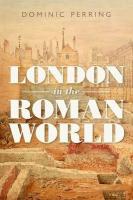
OUP (2022) h/b 573pp £40 (ISBN 9780198789000)
This is a fresh history of Roman London, set in a broad context. The book begins with an account of how the ancient city came to be discovered and investigated between the sixteenth and twentieth centuries. A series of influential figures drove forward research as and when opportunities arose. They included Sir Christopher Wren, Charles Roach, General Pitt-Rivers and Francis Haverfield. The ‘blitz’ during the Second World War and the subsequent reconstruction of London exposed many more sites. The Museum of London became home for some of the major finds. The planning reforms of 1990 (ushered in by Planning Policy Guidance Note 16) resulted in much developer-led archaeology.
The author then turns to the origins of London, which he identifies as a particularly contentious topic. Unlike many other Roman towns of southern Britain, such as Chichester or Silchester, London was not built on the site of an Iron Age oppidum. The pre-existing settlements along that section of the Thames, in so far as there were any, appear to have been agricultural. The traditional view was that London started life as a fort built during the Roman invasion. In the 1970s, however, a new view gained ground—namely, that London began not as a military base but as a trading centre; this thriving new town on the Thames presented a business opportunity for entrepreneurs from Gaul and elsewhere.
P. challenges the new orthodoxy. He argues that two parallel V shaped ditches recently found at the junction of Cannon street and Walbrook formed the west side of a large fortified enclosure. This was probably a fort built by the invading army in AD 43, while they were waiting for Claudius to arrive, although other interpretations are possible. (While Claudius took full credit for the conquest of Britain, he only joined the invading army at a late stage in the campaign.) P. argues that although London had a military origin, it rapidly developed into a trading centre and supply base. There is firm evidence for this not only from Tacitus, but also from the Bloomberg tablets which have come to light in recent years: see Tomlin, Roman London’s First Voices (Museum of London, 2016). Understandably, P. places reliance on Lacey Wallace’s meticulous study of pre-Boudican London, although he challenges her interpretation of the two V shaped ditches.
The history of London in the second half of the first century is less controversial. Boudica, head of the Iceni tribe, led a massive rebellion in AD 60-61. Her army stormed into London and burnt it to the ground. Traces of that destruction are clearly visible in the archaeological record. A period of reconstruction followed. During the 70s and 80s, under the Flavian emperors, London acquired monumental buildings, including a forum, basilica and amphitheatre. By then the whole of Britain (excluding the far north) was under Roman control. The imperial authorities were determined to make their mark on the province.
In the same period, they also commissioned a massive marble-clad arch at Richborough, to commemorate the conquest of Britannia. London never became a civitas capital, in which indigenous Britons managed local affairs and collected taxes on behalf of the Roman authorities. Instead, it emerged as the provincial capital, where both the procurator and the governor had their bases. The embellishment of London continued in the early second century, with the construction of a new, vast forum with monumental walls.
Thereafter more uncertainty attaches to London’s history. There was a catastrophic fire in the period AD 125-135, but we do not know whether that was accidental or the consequence of a war. Rebuilding followed. A new stone-walled fort was built at Cripplegate. Possibly soldiers were posted there as consequence of unrest; or perhaps they were simply serving the needs of the provincial governor. For reasons unknown, London contracted in the mid-second century. A layer of dark earth covers some remains of that period, which is evidence of abandonment. There was a revival in the late second/early third century. A massive stone wall was built around the city, parts of which are still visible. The famous Mithraeum (now displayed in the basement of Bloomberg’s European headquarters) was built in the period AD 225-250.
A curious episode began in AD 286, when Britain broke away from Rome. Carausius and his successor Allectus set themselves up in London as mini-emperors. Allectus established monumental temples and public buildings close to the north end of the Millenium Bridge. The usurpation was crushed by the emperor Constantius in AD 296, but Allectus’ architectural legacy survived. In the fourth century London diminished in importance. By then Britain was divided into four, later five, provinces. London was only capital of one of them. Many administrative buildings were abandoned (see pages 356-357). Britain dropped out of the Roman Empire soon after AD 400. As the author neatly puts it, ‘at some point London ceased to be a city’.
This fascinating book does much more than tell the story which is briefly summarised above. It is packed with analysis of individual buildings and discussion of social history. It does not pre-suppose extensive background knowledge. Anyone who enjoys history, whether or not they are a classicist, will read this work with great interest.
Rupert Jackson
